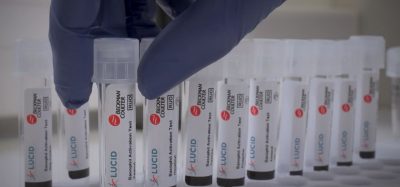Survey of undeclared allergenic peanuts in commercial foods by Taqman real time PCR
- Like
- Digg
- Del
- Tumblr
- VKontakte
- Buffer
- Love This
- Odnoklassniki
- Meneame
- Blogger
- Amazon
- Yahoo Mail
- Gmail
- AOL
- Newsvine
- HackerNews
- Evernote
- MySpace
- Mail.ru
- Viadeo
- Line
- Comments
- Yummly
- SMS
- Viber
- Telegram
- Subscribe
- Skype
- Facebook Messenger
- Kakao
- LiveJournal
- Yammer
- Edgar
- Fintel
- Mix
- Instapaper
- Copy Link
Posted: 4 November 2013 | Inés María López-Calleja Diaz, Silvia de la Cruz, Nicolette Pegels, Isabel González, Teresa García, and Rosario Martín, Department of Nutrition, Food Science and Food Technology, Complutense University of Madrid | No comments yet
Food allergies are a serious public health problem. Around one to two per cent of the population suffer from some type of food allergy and even higher prevalence levels (up to eight per cent) are estimated for children. Peanut (Arachis hypogaea) allergy is one of the most severe food allergies due to its persistence throughout the lifetime of individuals and its life-threatening character, even after the ingestion of minimal doses. Peanuts are widely used in different preparations like snacks and biscuits, and in the confectionary industry, both in their own right and as a cheap bulking agent for other products. Thus, avoidance of peanut-containing foods can be difficult for peanut allergen sufferers and food producers.


Inés María López-Calleja Díaz
Food allergies are a serious public health problem. Around one to two per cent of the population suffer from some type of food allergy and even higher prevalence levels (up to eight per cent) are estimated for children1-3. Peanut (Arachis hypogaea) allergy is one of the most severe food allergies due to its persistence throughout the lifetime of individuals and its life-threatening character, even after the ingestion of minimal doses4. Peanuts are widely used in different preparations like snacks and biscuits, and in the confectionary industry, both in their own right and as a cheap bulking agent for other products. Thus, avoidance of peanut-containing foods can be difficult for peanut allergen sufferers and food producers.
People suffering from a food allergy usually try to avoid consuming the food that can endanger their health. Despite this, the ingestion of peanuts often happens accidentally because of mislabelling of products, rework processes which include peanut-containing foods or cross-contamination during processing5,6. In this way, European legislation (EU) 1169/2011/EC 7 requires labelling of food products in respect of the contents of allergenic components, including peanuts among other tree nuts. Therefore, methods for analysis of peanut content in food are required in order to enforce the legislation.
Peanuts contain several major protein allergens, identified by their reactivity towards IgE in sera from sensitised subjects. Traditionally, protein detection methods have been widely used to detect the presence of allergenic proteins. Currently, enzyme-linked immunosorbent assay (ELISA) is probably the method that is most commonly used by the food industry and official food control agencies to assess the presence of allergens like peanut in food products8-11. However, the detection of peanut proteins is compromised by the fact that the food industry utilises a vast number of different ingredients and furthermore it employs a variety of food processing methodologies like heat treatment or roasting, thereby altering protein tertiary structure and thus interfering with protein detection12,13.
An alternative to the direct detection of proteins is provided by DNA-based methods. Several of such methods have recently been developed for the detection of peanut traces in food products14,15. The target molecules of these detection methods are not proteins but specific DNA sequences which are amplified by the polymerase chain reaction (PCR)16. Recent advances in DNA technology have led to the development of real-time PCR, which have proved to be very effective12,17. Commercial PCR based kits for the detection of peanuts are currently also available in the format of a real-time PCR kit (R-Biopharm, Darmstadt, Germany).
We hereby report the development and optimisation of a TaqMan real-time PCR method for the specific identification of peanut, based on selective amplification of ITS region sequences. The applicability of the assay was evaluated through screening analysis of a total of 123 commercial food samples.
Materials and methods: sample selection
Peanuts, nuts and various commercial brands of food were purchased from different local stores and several delicatessen markets and stored at room temperature in the dark. A wide range of plant and animal species were also included in the assays for specificity control purposes (Table 1).
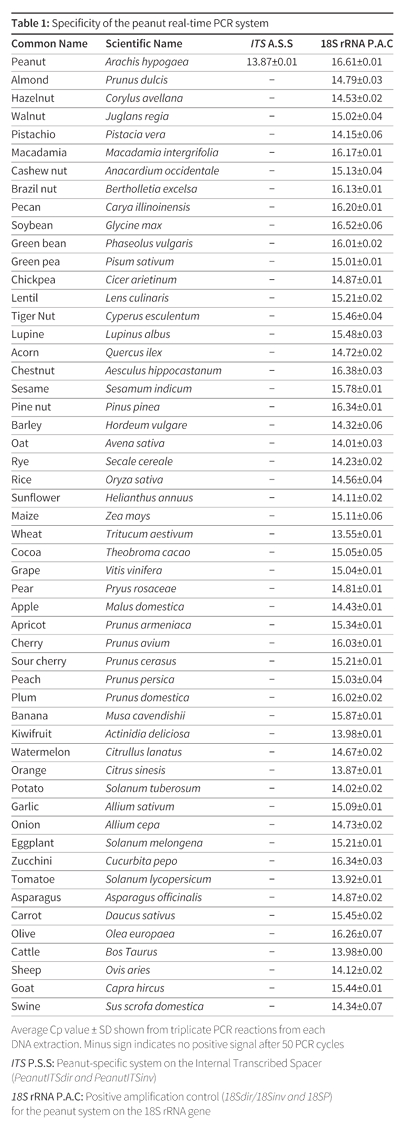

Peanuts were finely grounded and binary mixtures of raw and heat treated peanut (160ºC for 13 minutes) in wheat flour and cocoa containing 0.1, 1, 10, 100, 1000 and 10 000 ppm of peanuts were prepared to a final weight of 500 grams using a kitchen robot (Thermomix, Vorwerk).
Materials and methods: DNA extraction
Two hundred milligrams of each sample were homogenised with 860 mL of extraction buffer, pH 8.0 (10 mM Tris, 150 mM NaCl, 2 mM EDTA and one per cent SDS), 100 mL of 5 M guanidine hydrochloride and 40 mL of 20 mg/mL proteinase K (Merck, Darmstadt Germany), and incubated overnight at 55ºC with shaking at 60 rpm. The samples were then left to cool at room temperature. Five hundred mL of chloroform (Sigma Aldrich) were added to the lysate before centrifugation at 16,438 grams for 10 minutes.
Genomic DNA from the clear aqueous supernatant obtained after the centrifugation (500 mL) was purified using the Wizard DNA Clean-up System kit (Promega, Madison, WI, USA) as described by López-Calleja et al18. The DNA was eluted in 50 μL of sterile deionised water. DNA concentration was measured with a NanoDrop ND-1000 spectrophotometer (NanoDrop Technologies Inc., Montchanin, DE). Unless otherwise stated, three DNA replicates were extracted from each sample. A negative control sample was included in every DNA extraction.
Materials and methods: Oligonucleotide primers and probes
The oligonucleotides used in the real-time PCR assay were designed upon the Internal Transcribed Spacer (ITS) region and the nuclear 18S rRNA gene sequences from various plant and animal species available in the NCBI (National Center for Biotechnology Information) database.
Alignment and computer analysis of ITS1 sequences allowed the design of peanut-specific primers: PeanutITSdir/PeanutITSinv for the amplification of a DNA fragment of 90 bp, respectively. A dual-labelled TaqMan probe PeanutITSP with a reporter fluorophore at the 5’ end (6-carboxyfluorescein, FAM) and a quencher fluorophore at the 3’ end (Blackberry, BBQ), were designed to anneal within the ITS1 (Figure 1) fragment generated by amplification of the corresponding target.
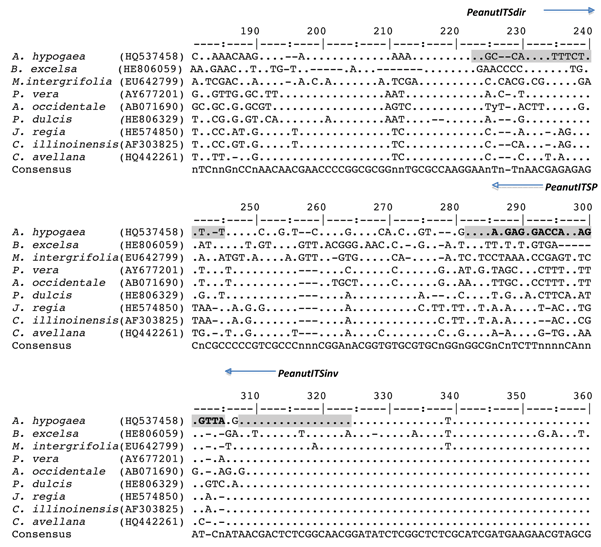

Figure 1. Deoxyribonucleic acid sequence alignment of the ITS region PCR products from peanut (Arachis hypogaea HQ537458), Brazil nut (Bertholletia excelsa HE806059), macadamia (Macadamia intergrifolia EU642799), pistachio (Pistacia vera AY677201), cashew nut (Anacardium occidentale AB071690), almond (Prunus dulcis HE806329), nut (Juglans regia HE574850), pecan (Carya illinoinensis AF303825) and hazelnut (Corylus avellana HQ442261). Primers PeanutITSdir,
PeanutITSinv, and PeanutITSP probe are highlighted
As a positive amplification control of real-time PCR experiments, a pair of universal primers (18Sdir/18Sinv) and a TaqMan probe (18SP) were designed on a conserved 18S rRNA gene fragment in all eukaryotic cells19. This PCR system was expected to yield amplicons of the same length (approximately 77 bp) in all species analysed in this work. The sequences and description of every primer and probe used in this study are listed in Table 2.


Materials and methods: real-time PCR
Real-time PCR was run under generic cycling conditions. The optimum PCR concentrations of primers yielding the highest endpoint fluorescence and the lowest Cp were experimentally determined for each set of primers: 300 nM for forward primers and 900 nM for reverse primers. The PCR reactions were carried out using the LightCycler® TaqMan® Master (Roche Diagnostics GmbH, Mannheim, Germany), 2 pmol of each TaqMan probe (TibMolBiol) and 2 mL of extracted DNA. Amplification reactions were performed in a total reaction volume of 10 mL in a glass capillary tube and were run on the LightCycler 2.0 Instrument (Roche Applied Science, Pensberg, Germany) with the following program: an amplification program of 55 cycles at 95ºC for five seconds and 60ºC for 30 seconds. Samples were then cooled to 40ºC for 30 seconds.
The crossing point value (Cp), which refers to the cycle number where the sample’s fluorescence significantly increases above the background level, was calculated automatically by the LightCycler software as the first maximum of the second derivative of the curve. The continual measurement of fluorescence is related to the amount of amplicon in the real time PCR, yielding a qualitative result on the presence of the target species.
Materials and methods: construction of standard curves and data analysis
To assess the efficiency, linear range and analytical sensitivity of the peanut-specific system (ITS1), standard curves were constructed using three arrays of binary mixtures of known peanuts’ content (Figure 2: raw peanut / wheat flour, heat treated peanut / wheat flour and raw peanut/cocoa) rendered under homogeneous conditions and containing increasing amounts of target material. The amount of target DNA in an unknown sample can be then measured by extrapolation of the Cp value obtained in the unknown sample in the corresponding standard curve of Cp values generated from known DNA concentrations of the target species. In addition, the correlation between the variables, crossing point (Cp) and concentration ([ ]) is semilogarithmic:
Cp = b log [ ] + a
Where b is the slope and a is the intercept.
Linearity test, sensitivity, accuracy and precision parameters of the species-specific real-time PCR systems were evaluated according to previously described methods20,21. To carry out the validation of the real-time PCR technique developed in this work, three separate DNA extractions of each peanut concentration were assayed in different days, using three replicates of each sample. Precision of the assay was evaluated by comparing the coefficient of variation (CV) values obtained in three different days versus those obtained in the same day, to assess the influence of random events (day of analysis, analyst, equipment, etc.) in the data obtained.
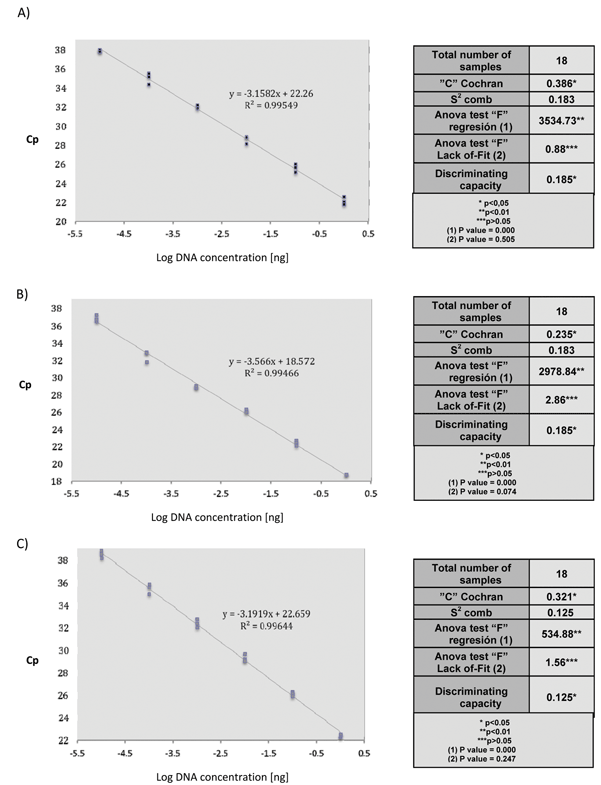

Figure 2. Linearity test, regression line and sensitivity parameters of the peanut-specific TaqMan system on the ITS region, using three different DNA extractions of six different peanut concentrations (10 000, 1000, 100, 10, 1, 0.1 ppm) of each binary mixture: (A) raw peanut/wheat flour mixture (B) raw peanut/cocoa mixture (C) heat treated peanut/wheat flour
Results and discussion: peanut-specific system on the ITS1 region
The real-time PCR assay developed in this work was based on the Internal Transcribed Spacer 1 region. The ITS region results an ideal candidate for primer designing, due to the high copy number of rRNA genes easy to amplify even from small quantities of DNA which contribute to increase the sensitivity of the present PCR. Also, the presence of a multi-copy gene makes the recovery of at least a few copies easier when subjected to intense thermal processing conditions. Commercial production processes of peanuts and tree nuts involve heat treatment or roasting which degrades DNA, thereby the selection of a short ITS1 amplicon of 90 bp is relevant for real-time PCR analysis aimed to detection of peanut in commercial food products. Moreover, the ITS region also presents a high degree of sequence variation required for identification of closely related species. In addition, the use of a conserved region in the nuclear 18S rRNA gene would provide a positive control as described before.
Results and discussion: specificity and sensitivity
Specificity and sensitivity are two important indices of performance of qualitative assays. The close phylogenetic relationships among peanut and tree nut species together with the varied number of plants and animals components that can be present in different commercial food products indicates the need to check the cross reactivity of the PCR against a wide range of species. Specificity of the peanut real-time PCR system on the ITS region was therefore assessed by analysis of the DNA extracted from 48 plant species and four animal species. As expected, the peanut specific PCR systems on the ITS region successfully detected, a DNA fragment of 90 bp from peanuts, while no positive amplification signal was obtained on the rest of the species tested. The 18S rRNA eukaryotic system amplified a 77 bp fragment from all samples tested (Table 1).
Efficiency, quantitation limit and statistical analysis
Three arrays of binary mixtures of raw and heat treated peanut (160ºC for 13 minutes) in wheat flour and cocoa containing increasing amounts of the target peanuts were used to construct the calibration curves using a simple regression model with the log input DNA concentration versus the Cp (Figure 2).
Cp values obtained from peanut calibration curves, plotted against the logarithm of the DNA concentrations, were used to test the sensitivity of the real-time PCR method. Figure 2 also shows the discriminating capacity, which is the least difference in logarithm of target DNA concentration in the sample that the analytical method can discriminate with a significant level. Linearity of the peanut real-time PCR response was also analysed. In this PCR system, the following parameters were evaluated: (a) Cochran’s test, which determined whether the variances of the responses obtained for each concentration of peanut DNA in the reference feeds were homogeneous, (b) regression analysis and (c) variance analysis with lack of-fit. All parameters were evaluated following previously described validation protocols.
The accuracy of the peanut assays was determined from the six P.S.S. percentages on the ITS (0.1, 1, 10, 100, 1000 and 10 000 ppm) of reference samples. Accuracy is reported as percentage recovery by the assay of known added amounts of analyte. Using the Snedecor F-test, it was verified that the concentration of DNA present in a sample did not affect the variation of the results. The values for Student’s t-test obtained demonstrated that the method was accurate, since no significant differences between 100 per cent and the mean recovery values were detected.
Results and discussion: commercial food products analysis
The method was also tested with regard to its suitability for the detection of peanut DNA in commercial food products. In this way, the ITS peanut-specific system was applied to the analysis of a collection of 123 commercial food products of different brands with different label declaration. PCR results were found to conform to the labelling in all samples except for 27 food samples with undeclared peanut in the labelling (Table 3).
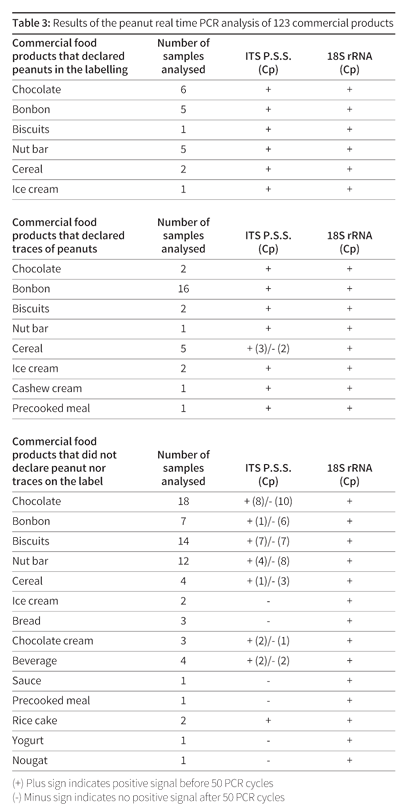

Table 4 shows the average Cp values obtained for all the food commercial samples and the content estimated for these food products by substitution of the Cps in the corresponding P.S.S. equations. For those commercial food products that gave positive the presence of peanut, it was probably due to contamination during the production, as they were produced by companies, which also process peanuts.
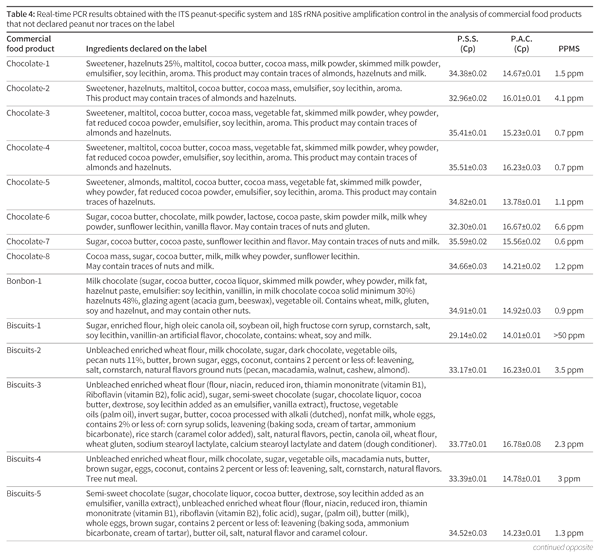

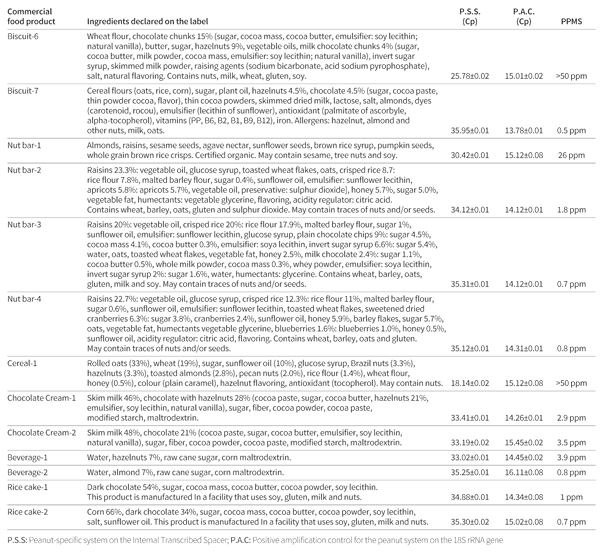

The degree of contamination of commercial food samples with peanuts, whether fraudulent or accidental, can cause a serious public health problem in sensitive individuals and therefore detection methods should provide a selective and sensitive detection level. One of the achievements of the assay described in this work is the ability to specifically detect down to 0.1 ppm of the target in food samples. This represents a major advantage compared to the very limited working range of detection of several ELISA kits10 and a lower detection level achieved in comparison to many other immunoassay techniques described to date22.
On the other hand, among PCR techniques, real-time PCR approaches12 report higher or similar detection levels when attempting the identification of peanut: Scaravelli et al17reported a real time PCR based on the Arah3 gene with a detection limit of 10 ppm. Whereas Stephan & Vieths15 described a real time PCR on the Arah2 gene combined with a sandwich ELISA with a detection limit of 2 ppm, Koppel et al23 developed two tetraplex real time PCR assays for the detection of several allergens, with a detection limit of 100 ppm on peanut based on Arah2 gene. Finally, Watanabe et al16 reported a PCR assay based on Arah3 combined with gel electrophoresis achieving a limit of detection of 10 ppm.
This observation suggests that the real-time PCR method proposed herein is beneficial because due to its high sensitivity it facilitates the detection of peanut traces in commercial food products. Moreover, this real-time PCR can also be useful for monitoring the effectiveness of cleaning processes from production units of the food industry, and as consequence, they can help to prevent the food allergic consumer from unintentional ingestion of hidden allergens.
Acknowledgements
This work was supported by the Programa de Vigilancia Sanitaria 2009/AGR/1489 of the Comunidad de Madrid (Spain) and by a project (AGL2010/15279) from the Ministerio de Ciencia e Innovación (Spain). Inés María López-Calleja Díaz is recipient of a Juan de la Cierva grant from the Ministerio de Ciencia e Innovación (Spain).
References
- Helm, R. M., & Burks, A. W. Mechanisms of food allergy. Current Opinion in Immunology. 2000; 12: 647-65
- Sicherer, S. H., Muñoz-Furlong, A., Murphy, R., Wood, R. A., & Sampson, H. A. Symposium: Pediatric Food Allergy. Pediatrics. 2003; 111: 1591
- Sicherer, S. H., Muñoz-Furlong, A., & Sampson, H. A. Prevalence of seafood allergy in the United States determined by a random telephone survey. Journal of Allergy and Clinical Immunology. 2004; 114: 159-165
- Hourihane, J. O’ B., Kilburn, S. A., Nordlee, J. A., Hefle, S. L., Taylor, S. L., & Warner, J. O. An evaluation of the sensitivity of subjects with peanut allergy to very low doses of peanut protein: a randomized, double-blind, placebo- controlled food challenge study. Journal of Allergy and Clinical Immunology. 1997; 100: 596–600
- Sampson, H., Mendelson, L., & Rosen, J. Fatal and near-fatal anaphylactic reactions to food in children and adolescents. New England Journal of Medicine. 1992; 327: 380-384
- Yunginger, J., Sweeney, K., Sturner, W., Giannandrea, L., Teigland, J., Bray, M., et al. Fatal food-induced anaphylaxis. Journal of the American Medical Association. 1988; 260: 1450–1452
- Official Journal of the European Union, 2011. Regulation (EU) 1169/2011/EC of the European Parliament and of the Council of 25 October 2011 on the provision of food information to consumers, amending Regulations (EC) No 1924/2006 and (EC) No 1925/2006 of the European Parliament and of the Council, and repealing Commission Directive 87/250/EEC, Council Directive 90/496/EEC, Commission Directive 1999/10/EC, Directive 2000/13/EC of the European Parliament and of the Council, Commission Directives 2002/67/EC and 2008/5/EC and Commission Regulation (EC) No 608/2004, L 304, 18-43
- Besler, M. Determination of allergens in food. Trends in Analytical Chemistry. 2001; 20: 662–672
- Keck-Gassenmeier, B., Benet, S., Rosa, C., & Hischenhuber, C. Determination of peanut traces in food by a commercially-available ELISA test. Food and Agricultural Immunology. 1999; 11: 243–250
- Poms, R. E., Agazzi, M. E., Bau, A., Brohée, M., Capelletti, C., Nørgaard, J. V., et al. Interlaboratory validation study of five commercial ELISA test kits for the determination of peanut proteins in biscuits and dark chocolate. Food Additives and Contaminants. 2005; 22: 104-112
- Kiening, M., Niessner, R. Drs. E., Baumgartner, S., Krska, R., Bremer, M., Tomkies, V., et al. Sandwich immunoassays for the determination of peanut and hazelnut traces in foods. Journal of Agricultural and Food Chemistry. 2005; 53: 3321-3327
- Hird, H., Lloyd, J., Goodier, R., Brown, J., & Reece, P. Detection of peanut using real-time polymerase chain reaction. European Food Research and Technology. 2003; 217: 265-268
- Immer, U. Detecting allergens in food. Woodhead Publishing Limited, Cambridge. 2006; 330-347
- Sforza, S., Scaravelli, E., Corradini, R., & Marchelli, R. Unconventional method based on circular dichroism to detect peanut DNA in food by means of a PNA probe and a cyanine dye. Chirality. 2005; 17: 515-521
- Stephan, O., & Vieths, S. Development of a real-time PCR and a sandwich ELISA for detection of potentially allergenic trace amounts of peanut (Arachis hypogaea) in processed foods. Journal of Agricultural and Food Chemistry. 2004; 52: 3754-3760
- Watanabe, T., Akiyama, H., Maleki, S., Yamakawa, H., Iijima, K., Yamazaki, F., et al. A specific qualitative detection method for peanut (Arachis Hypogaea) in foods using polymerase chain reaction. Journal of Food Biochemistry. 2006; 30: 215-233
- Scaravelli, E., Brohee, M., Marchelli, R., & Van Hengel, A. Development of three real-time PCR assays to detect peanut allergen residue in processed food products. European Food Research and Technology. 2008; 227: 857-869
- López-Calleja, I., González, I., Fajardo, V., Martín, I., Hernández, P.E., García, T., et al. Quantitative detection of goats’ milk in sheep’s milk by real-time PCR. Food Control. 2007; 18: 1466-1473
- Pegels, N., González, I., García, T., & Martín, R. Detection of banned ruminant-derived material in industrial feedstuffs by Taqman real-time PCR assay. Journal of Food Protection. 2011; 74: 1300-1308
- Camacho, M. A., Torres, A. I., Gil-Alegre, M. E., Obregón, M. M., & Ruz, V. Validation protocol of analytical methods for finished pharmaceutical products. STP Pharma Pratiques. 1993; 3: 197-202
- International Conference on Harmonisation of Technical Requirements for Regis- tration of Pharmaceuticals for Human Use (ICH). Harmonised tripartite guideline. Validation of analytical procedures: text and methodology Q2 (R1). Available at http://drugtiger.com/d/gdoc/media417.pdf. 2005
- Pomés, A., Helm, R.M., Bannon, G.A., Burks, A.W., Tsay, A., & Chapman, M.D. Monitoring peanut allergen in food products by measuring Arah1. Journal of Allergy and Clinical Immunology. 2003; 111: 640-645
- Koppel, R., Dvorak, V., Zimmerli, F., Breitenmoser, A., Eugster, A., & Waiblinger, H. U. Two tetraplex real-time PCR for the detection and quantification of DNA from eight allergens in food. European Food Research and Technology. 2010; 230: 367–374
Biography


Inés María López-Calleja Díaz
Inés María López-Calleja Díaz is a Spanish scientist brought up abroad in a British-American background. Inés obtained a master’s degree in Veterinary Science (First class honours) at the Universidad Complutense de Madrid in 2001. She started a PhD at this same University and did an externship at Trinity College (Dublin, Ireland). She accomplished her doctorate with both: Summa Cum Laude as well as the European Phd. Recognition in 2007. She also received the Best Doctorate Award of the year in Food Science and Technology.
Inés moved to New York with a Fulbright scholarship which allowed her to obtain a postdoc position at the Department of Food Science at Cornell University. There, she worked on research in the field of design and expression of recombinant proteins and in the design and construction of single chain antibodies and acquired the expertise in nanotechnology applied to the detection of different food components and pathogens.
Inés returned in 2009 to the Universidad Complutense de Madrid with a nationwide grant program from the Spanish Ministry of Science and Innovación. At the moment she has a research position in which she is developing two research lines: one based on real-time PCR techniques for the detection of a wide range of allergenic nuts and seeds (peanut, almond, hazelnut, walnut, cashew, pecan, Brazil nut, pistachio, macadamia, poppy seeds, sesame, sunflowers, flaxseeds etc.) in foods. The other is focused on the obtention of recombinant peptides and antibodies against protein nut allergens for tree nut detection.
She has published a total of 30 articles in relevant international journals, participated in more than 25 lectures and conferences, and has been involved in a large number of research projects.




